Inserisci Immagine: 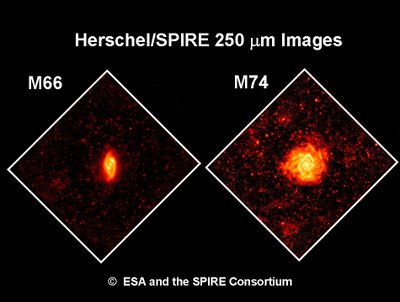
Dopo le prime immagini inviate a terra il mese scorso dal telescopio spaziale europeo Herschel, il più grande e potente telescopio spaziale ad infrarossi che sia mai stato lanciato nello spazio, ecco adesso qualcosa di ancora più strabiliante.
Herschel ha compiuto le prime osservazioni di test del cosmo utilizzando tutti i suoi strumenti di bordo ed i primi risultati, al di là di ogni migliore previsione, sono a dir poco spettacolari: dozzine di nuove galassie e la presenza di acqua e carbonio. E tutto solamente durante la prima "occhiata".
L'immagine qui sopra mostra M66 e M74 riprese alla lunghezza d'onda di 250 micron, un valore il più grande di ogni precedente osservazione spaziale nell'infrarosso, eppure tale valore è all'estremo inferiore delle capacità di Herscel.
SPIRE è progettato per studiare la formazione di stelle nella nostra Galassia, in quelle vicine e nell'Universo distante. Scrutare il cosmo e trovare Galassie lontanissime significa nello stesso tempo anche guardare lontano nel tempo poiché la luce proveniente da queste ha impiegato tantissimo tempo per arrivare sino a noi (da Herscel, cioè!) e così facendo possiamo "guardare" gli stessi processi che hanno portato alla formazione della nostra Galassia.
Qui sotto ecco la galassia M6, che dista 36 milioni di anni luce da noi nella costellazione del Leone, registrata a differenti lunghezze d'onda, a sinistra dal telescopio spaziale NASA Spitzer, a destra da Herscel.
Inserisci Immagine: 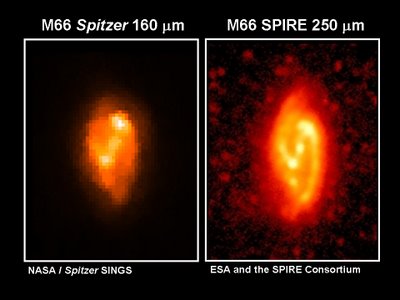
Ecco la galassia M74, a 24 milioni di anni luce di distanza nella costellazione dei Pesci. A sinistra Spitzer, a destra Herscel.
Inserisci Immagine: 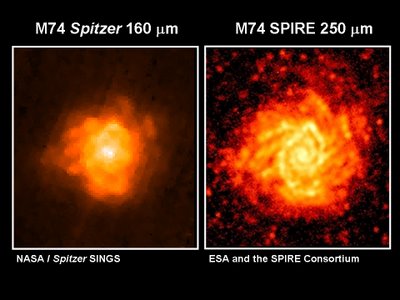
Lo specchio principale di Herschel è di 3,5 metri di diametro, quasi quattro volte più largo di ogni precedente telescopio spaziale ad infrarossi, ed i primi risultati ottenuti sono una ulteriore conferma delle sue capacità e fanno ben sperare per il futuro.
Qui sotto si possono osservare le immagini di M74 a tre differenti lunghezze d'onda nel far-infrared.
Inserisci Immagine: 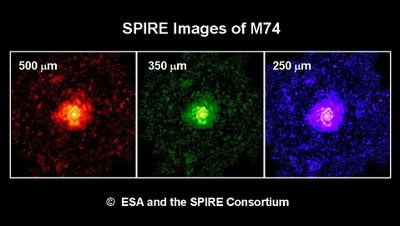 HIFI (Heterodyne Instrument for the Far-Infrared)
HIFI (Heterodyne Instrument for the Far-Infrared)HIFI (Heterodyne Instrument for the Far-Infrared) è un altro potente "ospite" di Herschel. Il 22 giugno si è messo all'opera per cercare gas molecolare riscaldato da stelle massive nella regione di formazione stellare DR21 nella costellazione del Cigno. HIFI ha prodotto dati molto promettenti relativi alla composizione della regione studiata con un'accuratezza e risoluzione senza precedenti. Esso funziona "zoomando" su specifiche lunghezze d'onda, rilevando quindi le linee spettrali che rappresentano inequivocabilmente particolari atomi e molecole, riuscendo anche a determinare le condizioni fisiche degli oggetti osservati. In questo modo è possibile studiare il ruolo che particolari gas e polvere cosmica hanno nella formazione di stelle e nell'evoluzione delle galassie.
Utilizzando HIFI gli scienziati hanno osservato all'interno di DR21 la presenza di carbonio ionizzato, monossido di carbonio e di acqua.
Inserisci Immagine: 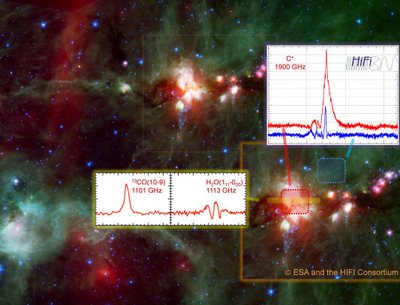
E' anche importante riportare anche che dietro ad HIFI vi è un consorzio di 25 istituzioni di 13 paesi che hanno messo in comune le proprie conoscenze per arrivare a costruire questo strumento.
PACS (Photodetector Array Camera and Spectrometer)La prima osservazione con lo strumento PACs (Photodetector Array Camera and Spectrometer) è stata compiuta il 23 giugno scorso. Primo obiettivo è stata la stella morente conosciuta con il nome di Cat's Eye Nebula (la nebulosa Occhio di Gatto), scoperta da William Herschel nel 1786.
Essa è composta da un guscio piuttosto complesso di gas, espulso da una stella morente. In generale queste nebulose sono molto spettacolari, ma come è possibile che una stella sferica possa produrre nebulose così complesse? Per saperne di più gli scienziati devono riuscire a guardare i processi che si verificano in prossimità di queste stelle morenti, dove la materia è espulsa.
Con lo spettrometro PACS è possibile per la prima volta catturare immagini in linee spettrali e vedere come il vento generato dalla stella (morente) dà forma alla nebulosa in tutte e tre le dimensioni.
PACs ha osservato la nebulosa Cat's Eye in due linee spettrali, azoto ed ossigeno ed ha realizzato una piccola mappa della nebulosa nella banda dei 70 micron rilevando la struttura di un anello di polvere con un'apertura da una parte.
Inserisci Immagine: 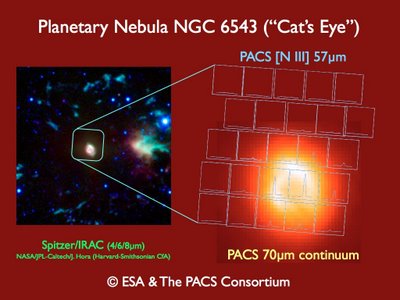
Adesso Herschel è nella fase in cui gli scienziati di missione ne stanno verificando la performance. Gli strumenti saranno ulteriormente testati e calibrati fino a novembre, quando potrà avere inizio la missione scientifica.
Fonte: newsspazio.blogspot.com





